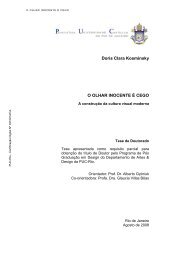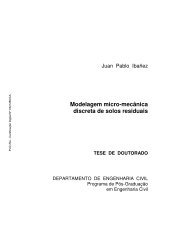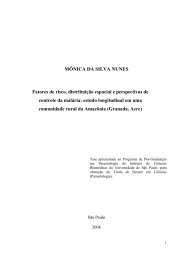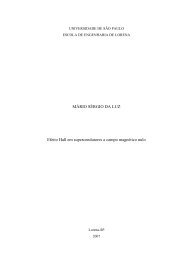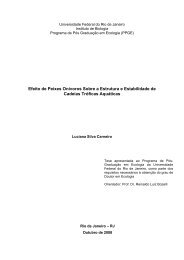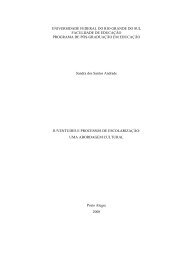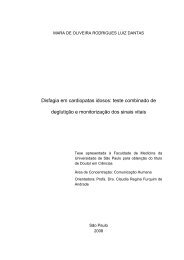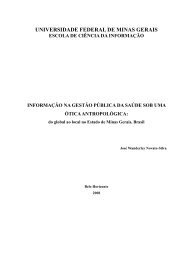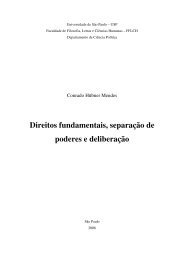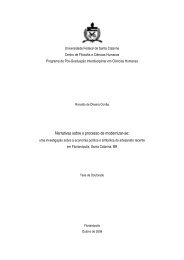Create successful ePaper yourself
Turn your PDF publications into a flip-book with our unique Google optimized e-Paper software.
D.A.R. Magalhães et al. / Molecular Immunology 42 (2005) 1043–1048 1045deposited in each spot. After stripping, the membranes weresubsequently used for hybridization with cDNA complexprobes (sample hybridization).The characterization of each cDNA sequence wasupdated using the Eloge ® (Ipsogen, France, www.ipsogen.fr) software, which runs in our local server and links eachclone ID with the genome data banks (GenBank, www.ncbi.nlm.ih.gov and S.O.U.R.C.E., http://genome-www5.stanford.edu/cgi-bin/source/sourceSearch), allowing a setof information such as sequence, biological and molecularfunctions, chromosomal location, percent identity withhumans and expression in different tissues.2.4. Complex cDNA probe preparation andhybridizationIn this study, we refer to the radioactive cDNA originatedfrom the thymus RNA samples as complex probe and thePCR product originated from the clones and deposited on thenylon microarrays as target.The 33 P-labeled cDNA complex probes were prepared byreverse transcription of 10 g of thymus total RNA usingoligo dT 12–18 as primer. One hundred microliters of 33 P-cDNA complex probe containing 30–50 million cpm washybridized with nylon microarrays as previously described(Bertucci et al., 2002; Nguyen et al., 1995; Verdeil et al.,2002).2.5. Imaging acquisitionWe used imaging plates and a phosphor imager (Cyclone,Packard Instruments, USA) to capture the hybridizationsignals and the Array Vision ® (Imaging ResearchInc. USA) to quantify the signals with local backgroundsubtraction, whose spots were matched with a templategrid.The ratio between vector probe hybridization values andcomplex probe hybridization values for each spot was usedas reference normalization value. We employed also totalintensity normalization, using the median expression value(Quackenbush, 2002).gestation). The program calculates a global error chance, thefalse discovery rate (FDR) and a <strong>gene</strong> error chance (q-value).2.7. Hierarchical clusteringWe used a hierarchical clustering algorithm, comparingmeans of different <strong>gene</strong>s whose standard deviationdid not overlap, whose objective was to compute a dendrogramthat assembles all elements into a single tree.The software for this algorithm can be obtained fromthe author (http://rana.stanford.edu/clustering) (Eisen et al.,1998). Before clustering, the <strong>gene</strong> expression values weremedian-centered and converted to log. We used the Pearsoncorrelation distance metrics and average linkage for clusteringorganization.From the 1,576 sequences present on the microarrays, 315(20%) were excluded from the calculations by the softwaredue to their low statistical significance (in this case were analyzed1,261 sequences, including 200 named <strong>gene</strong>s and 1,061ESTs).In order to cluster only <strong>gene</strong>s whose expression valueswere significant, we used the values for the induced and repressed<strong>gene</strong>s detected by the SAM method.3. Results3.1. Monitoring thymocyte maturationThe detection of the T-cell receptor TRBV8.1-BD2.1 rearrangedDNA segment served as an indication of thymocytematuration during the fetal development of the thymus. Wedetected the onset of TRBV8.1 V(D)J recombination at 14days gestation in the heterozygous (Balb-c × C57Bl/6) F 1fetuses whose amount of the rearranged DNA fragment increasedduring thymus ontogeny (Fig. 1).3.2. Hierarchical clustering of significant <strong>gene</strong>sThe hierarchical cluster analysis, computing all the 1,261sequences and probes from thymi of fetuses of different2.6. cDNA-microarray data analysisThe <strong>gene</strong> expression data analyzed here were obtainedfrom three independent determinations for each day of fetaldevelopment.We used the SAM method (Significance Analysisof Microarrays available at http://www-stat.stanford.edu/∼tibs/SAM/index.html) Tusher et al. (2001) to analyzethe significant variations in the <strong>gene</strong> expression. Thismethod is based on t-test statistics, specially modified to highthroughput analysis. The significant variations in the <strong>gene</strong> expressionof the developing thymus were compared with the 14days p.c. (14 versus 15, 14 versus 16 and 14 versus 17 days ofFig. 1. Detection of the recombined TRBV8.1-BD2.1 segment in genomicDNA during thymus ontogeny of (Balb-c × C57Bl/6) F 1 hybrid mice.(−) = PCR without DNA, A31 = murine Balb/3T3 derived fibroblast cell lineDNA.



